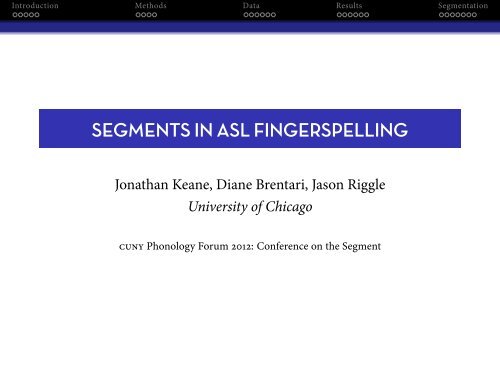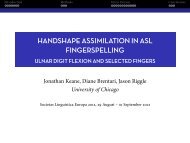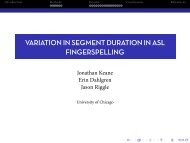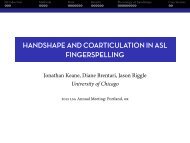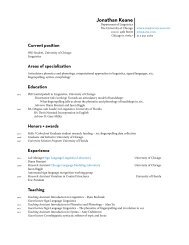Segments in asl Fingerspelling - Jonathan Keane
Segments in asl Fingerspelling - Jonathan Keane
Segments in asl Fingerspelling - Jonathan Keane
You also want an ePaper? Increase the reach of your titles
YUMPU automatically turns print PDFs into web optimized ePapers that Google loves.
Introduction Methods Data Results Segmentation<br />
SEGMENTS IN ASL FINGERSPELLING<br />
<strong>Jonathan</strong> <strong>Keane</strong>, Diane Brentari, Jason Riggle<br />
University of Chicago<br />
CUNY Phonology Forum 2012: Conference on the Segment
Introduction Methods Data Results Segmentation<br />
Outl<strong>in</strong>e<br />
Introduction<br />
Background<br />
P<strong>in</strong>ky Extension<br />
Methods<br />
Data collection<br />
Cod<strong>in</strong>g method<br />
Data<br />
Description<br />
Condition<strong>in</strong>g variables<br />
Results<br />
Model<br />
Segmentation<br />
O-I-L<br />
B-U-I-L-D-I-N-G<br />
A-C-T-I-V-I-T-Y
Introduction Methods Data Results Segmentation<br />
Background<br />
A basic description of f<strong>in</strong>gerspell<strong>in</strong>g<br />
▸ F<strong>in</strong>gerspell<strong>in</strong>g is a type of loanword system that makes up<br />
anywhere from 12–35% of ASL discourse (Padden, 1991; Padden<br />
and Gunsauls, 2003).<br />
▸ Simplistically, f<strong>in</strong>gerspell<strong>in</strong>g is a set of static (except for -J- and<br />
-Z-) handshape-orientation comb<strong>in</strong>ations strung together<br />
sequentially, where each maps to one letter <strong>in</strong> an English word.<br />
▸ Many note that this description is not quite accurate (Wilcox<br />
(1992); Akamatsu (1982) &c.).<br />
a b c d e f<br />
j<br />
z
Introduction Methods Data Results Segmentation<br />
Background<br />
What f<strong>in</strong>gerspell<strong>in</strong>g looks like; full speed<br />
data.mp4
Introduction Methods Data Results Segmentation<br />
Background<br />
What f<strong>in</strong>gerspell<strong>in</strong>g looks like; half speed<br />
data.mp4
Introduction Methods Data Results Segmentation<br />
Background<br />
Broad questions<br />
1. How do handshapes <strong>in</strong> f<strong>in</strong>gerspell<strong>in</strong>g vary across environments,<br />
and what is the best explanation for this variation<br />
2. Is it possible to divide f<strong>in</strong>gerspell<strong>in</strong>g cleanly <strong>in</strong>to discrete<br />
segments<br />
Specifically, what can p<strong>in</strong>ky extension <strong>in</strong> f<strong>in</strong>gerspell<strong>in</strong>g tell us<br />
F<strong>in</strong>gerspell<strong>in</strong>g is an especially good phenomenon to look at<br />
handshape variation as well as segmentation because it is quick and<br />
sequential, unlike handshape <strong>in</strong> sign<strong>in</strong>g.
Introduction Methods Data Results Segmentation<br />
P<strong>in</strong>ky Extension<br />
Coarticulation <strong>in</strong> sign languages<br />
There has been much work on coarticulation <strong>in</strong> speech, however<br />
sign languages, and f<strong>in</strong>gerspell<strong>in</strong>g especially has been explored less:<br />
▸ Cheek (2001) looks at coarticulation of p<strong>in</strong>ky extension on lexical<br />
signs as a proxy for handshape generally.<br />
▸ Jerde et al. (2003) mentions that there is coarticulation with<br />
respect to the p<strong>in</strong>ky.<br />
▸ Tyrone et al. (2010) describes some park<strong>in</strong>sonian signers who<br />
blend letters together.<br />
▸ Hoopes (1998) notes p<strong>in</strong>ky extension and coarticulation <strong>in</strong><br />
f<strong>in</strong>gerspell<strong>in</strong>g.
Introduction Methods Data Results Segmentation<br />
Data collection<br />
Record<strong>in</strong>g specifications<br />
▸ 4 native signers, 1 early leaner (2 (native) coded so far) produced<br />
▸ 300 words<br />
▸<br />
▸<br />
▸<br />
100 names<br />
100 nouns<br />
100 non-English words<br />
▸ repeat<strong>in</strong>g each word twice<br />
▸ be<strong>in</strong>g recorded by 2 or 3 video cameras<br />
▸ record<strong>in</strong>g at 60 FPS<br />
▸ for a total of 8,115 apogees
Introduction Methods Data Results Segmentation<br />
Cod<strong>in</strong>g method<br />
Apogee detection<br />
We used a comb<strong>in</strong>ation of human coders, algorithmic averag<strong>in</strong>g,<br />
forced alignment, and verification to code tim<strong>in</strong>g data.<br />
Apogees<br />
▸ are the po<strong>in</strong>t where the hand reached a target handshape and<br />
orientation, or<br />
▸ the po<strong>in</strong>t of m<strong>in</strong>imum <strong>in</strong>stantaneous velocity of all of the<br />
articulators, but<br />
▸ crucially are not def<strong>in</strong>ed as the canonical form.<br />
(<strong>Keane</strong> et al., 2011)
Introduction Methods Data Results Segmentation<br />
Cod<strong>in</strong>g method<br />
P<strong>in</strong>ky extension annotation<br />
Feature annotation<br />
▸ We extracted still images from the data that has been coded.<br />
▸ We hand coded p<strong>in</strong>ky extension for all apogees.<br />
▸ There are total of 4,741 word medial apogees annotated.<br />
Two goals<br />
▸ A simple task with only a m<strong>in</strong>imal amount of tra<strong>in</strong><strong>in</strong>g necessary<br />
▸ A metric that would apply regardless of how canonical a given<br />
handshape was
Introduction Methods Data Results Segmentation<br />
Cod<strong>in</strong>g method<br />
P<strong>in</strong>ky extension<br />
▸ The tip of the p<strong>in</strong>ky was above the plane perpendicular to the<br />
palmar plane, at the base of the p<strong>in</strong>ky f<strong>in</strong>ger (the MCP jo<strong>in</strong>t).<br />
▸ The proximal <strong>in</strong>terphalangeal jo<strong>in</strong>t (PIP) was more than half<br />
extended.<br />
-R- [+ext] -R- [−ext] -L- [+ext] -L- [−ext] -D- [+ext] -D- [−ext]<br />
Apogees from C-H-R-I-S, D-I-N-O-S-A-U-R, O-I-L, W-O-R-L-D, B-U-I-L-D-I-N-G,<br />
W-O-R-L-D
Introduction Methods Data Results Segmentation<br />
Cod<strong>in</strong>g method<br />
P<strong>in</strong>ky extension<br />
▸ The tip of the p<strong>in</strong>ky was above the plane perpendicular to the<br />
palmar plane, at the base of the p<strong>in</strong>ky f<strong>in</strong>ger (the MCP jo<strong>in</strong>t).<br />
▸ The proximal <strong>in</strong>terphalangeal jo<strong>in</strong>t (PIP) was more than half<br />
extended.<br />
-R- [+ext] -R- [−ext] -L- [+ext] -L- [−ext] -D- [+ext] -D- [−ext]<br />
Apogees from C-H-R-I-S, D-I-N-O-S-A-U-R, O-I-L, W-O-R-L-D, B-U-I-L-D-I-N-G,<br />
W-O-R-L-D
Introduction Methods Data Results Segmentation<br />
Cod<strong>in</strong>g method<br />
P<strong>in</strong>ky extension<br />
▸ The tip of the p<strong>in</strong>ky was above the plane perpendicular to the<br />
palmar plane, at the base of the p<strong>in</strong>ky f<strong>in</strong>ger (the MCP jo<strong>in</strong>t).<br />
▸ The proximal <strong>in</strong>terphalangeal jo<strong>in</strong>t (PIP) was more than half<br />
extended.<br />
-R- [+ext] -R- [−ext] -L- [+ext] -L- [−ext] -D- [+ext] -D- [−ext]<br />
Apogees from C-H-R-I-S, D-I-N-O-S-A-U-R, O-I-L, W-O-R-L-D, B-U-I-L-D-I-N-G,<br />
W-O-R-L-D
Introduction Methods Data Results Segmentation<br />
Description<br />
Handshape variation<br />
expected (bcfijy)<br />
unexpected (others)<br />
3500<br />
3000<br />
2500<br />
count<br />
2000<br />
1500<br />
1000<br />
500<br />
0<br />
−ext<br />
+ext<br />
handshape variant<br />
−ext<br />
+ext
Introduction Methods Data Results Segmentation<br />
Description<br />
Handshape variation<br />
expected (bfijy)<br />
unexpected (others)<br />
3500<br />
3000<br />
2500<br />
count<br />
2000<br />
1500<br />
1000<br />
500<br />
0<br />
−ext<br />
+ext<br />
handshape variant<br />
−ext<br />
+ext
Introduction Methods Data Results Segmentation<br />
Condition<strong>in</strong>g variables<br />
B-U-I-L-D-I-N-G; full speed<br />
build<strong>in</strong>g.mp4<br />
-B- -U- -I- -L- -D- -I- -N- -G-
Introduction Methods Data Results Segmentation<br />
Condition<strong>in</strong>g variables<br />
B-U-I-L-D-I-N-G; half speed<br />
build<strong>in</strong>g.mp4<br />
-B- -U- -I- -L- -D- -I- -N- -G-
Introduction Methods Data Results Segmentation<br />
Condition<strong>in</strong>g variables<br />
What affects the -L- handshape<br />
-B- -U- -I- -L- -D- -I- -N- -G-
Introduction Methods Data Results Segmentation<br />
Condition<strong>in</strong>g variables<br />
What affects the -L- handshape<br />
-B- -U- -I- -L- -D- -I- -N- -Gword<br />
type<br />
name, noun, non-English<br />
signer<br />
s1, s2
Introduction Methods Data Results Segmentation<br />
Condition<strong>in</strong>g variables<br />
What affects the -L- handshape<br />
-B- -U- -I- -L- -D- -I- -N- -Gword<br />
type<br />
name, noun, non-English<br />
signer<br />
s1, s2<br />
previous handshape
Introduction Methods Data Results Segmentation<br />
Condition<strong>in</strong>g variables<br />
What affects the -L- handshape<br />
-B- -U- -I- -L- -D- -I- -N- -Gword<br />
type<br />
name, noun, non-English<br />
signer<br />
s1, s2<br />
previous handshape<br />
previous transition time
Introduction Methods Data Results Segmentation<br />
Condition<strong>in</strong>g variables<br />
What affects the -L- handshape<br />
-B- -U- -I- -L- -D- -I- -N- -Gword<br />
type<br />
name, noun, non-English<br />
signer<br />
s1, s2<br />
previous handshape<br />
follow<strong>in</strong>g handshape<br />
previous transition time
Introduction Methods Data Results Segmentation<br />
Condition<strong>in</strong>g variables<br />
What affects the -L- handshape<br />
-B- -U- -I- -L- -D- -I- -N- -Gword<br />
type<br />
name, noun, non-English<br />
signer<br />
s1, s2<br />
previous handshape<br />
previous transition time<br />
follow<strong>in</strong>g handshape<br />
follow<strong>in</strong>g transition time
Introduction Methods Data Results Segmentation<br />
Condition<strong>in</strong>g variables<br />
What affects the -N- handshape<br />
-B- -U- -I- -L- -D- -I- -N- -Gword<br />
type<br />
name, noun, non-English<br />
signer<br />
s1, s2<br />
previous handshape<br />
previous transition time<br />
follow<strong>in</strong>g handshape<br />
follow<strong>in</strong>g transition time
Introduction Methods Data Results Segmentation<br />
Condition<strong>in</strong>g variables<br />
What affects the -D- handshape<br />
-B- -U- -I- -L- -D- -I- -N- -Gword<br />
type<br />
name, noun, non-English<br />
signer<br />
s1, s2<br />
previous handshape<br />
previous transition time<br />
follow<strong>in</strong>g handshape<br />
follow<strong>in</strong>g transition time
Introduction Methods Data Results Segmentation<br />
Specific questions – coarticulation<br />
1. Does the extension of the p<strong>in</strong>ky f<strong>in</strong>ger spread to neighbor<strong>in</strong>g<br />
apogees<br />
2. What environments condition this coarticulation Preced<strong>in</strong>g<br />
handshape Follow<strong>in</strong>g handshape &c.<br />
3. Do all handshapes with an extended p<strong>in</strong>ky condition<br />
coarticulation equally<br />
4. Is this coarticulation gradient
Introduction Methods Data Results Segmentation<br />
Model<br />
P<strong>in</strong>ky extension by surround<strong>in</strong>g handshape<br />
handshape − immediately follow<strong>in</strong>g<br />
ijy<br />
bcf<br />
other<br />
percent<br />
p<strong>in</strong>ky<br />
+ext<br />
● 0.0<br />
● 0.1<br />
● 0.2<br />
● 0.3<br />
● 0.4<br />
other bcf ijy<br />
handshape − immediately previous
Introduction Methods Data Results Segmentation<br />
Model<br />
Us<strong>in</strong>g a multilevel logistic regression, we determ<strong>in</strong>ed that the<br />
follow<strong>in</strong>g have a significant effect on p<strong>in</strong>ky extension:<br />
▸ handshape of the previous apogee<br />
▸ handshape of the follow<strong>in</strong>g apogee<br />
▸ word type<br />
▸ <strong>in</strong>teraction of follow<strong>in</strong>g handshape and follow<strong>in</strong>g transition time
Introduction Methods Data Results Segmentation<br />
Model<br />
Near -I-, -J-, and -Y-; mean transition times<br />
probability p<strong>in</strong>ky extension<br />
1.0<br />
0.8<br />
0.6<br />
0.4<br />
0.2<br />
0.0<br />
1.0<br />
0.8<br />
0.6<br />
0.4<br />
0.2<br />
0.0<br />
1.0<br />
0.8<br />
0.6<br />
0.4<br />
0.2<br />
0.0<br />
1.0<br />
0.8<br />
0.6<br />
0.4<br />
0.2<br />
0.0<br />
1.0<br />
0.8<br />
0.6<br />
0.4<br />
0.2<br />
0.0<br />
a<br />
● ● ●<br />
●<br />
●<br />
g<br />
m<br />
●<br />
● ● ●<br />
s<br />
●<br />
●<br />
●<br />
● ● ● ●<br />
y<br />
● ● ● ●<br />
neither<br />
previous<br />
follow<strong>in</strong>g<br />
both<br />
b<br />
● ● ● ●<br />
●<br />
●<br />
h<br />
n<br />
●<br />
● ● ●<br />
t<br />
● ● ●<br />
●<br />
neither<br />
●<br />
previous<br />
z<br />
●<br />
follow<strong>in</strong>g<br />
●<br />
●<br />
●<br />
●<br />
both<br />
●<br />
c<br />
● ● ●<br />
i<br />
● ● ● ●<br />
●<br />
●<br />
neither<br />
●<br />
●<br />
previous<br />
o<br />
u<br />
●<br />
●<br />
follow<strong>in</strong>g<br />
●<br />
●<br />
both<br />
condition<strong>in</strong>g handshape position<br />
d<br />
● ● ●<br />
●<br />
j<br />
● ● ● ●<br />
p<br />
● ● ●<br />
●<br />
neither<br />
●<br />
previous<br />
v<br />
●<br />
follow<strong>in</strong>g<br />
●<br />
●<br />
both<br />
e<br />
● ● ●<br />
●<br />
●<br />
●<br />
●<br />
k<br />
q<br />
w<br />
●<br />
●<br />
● ● ●<br />
neither<br />
previous<br />
follow<strong>in</strong>g<br />
●<br />
●<br />
●<br />
●<br />
both<br />
f<br />
● ● ● ●<br />
●<br />
●<br />
●<br />
●<br />
l<br />
r<br />
x<br />
●<br />
●<br />
●<br />
●<br />
● ● ● ●<br />
neither<br />
previous<br />
follow<strong>in</strong>g<br />
both
Introduction Methods Data Results Segmentation<br />
Model<br />
Near -I-, -J-, and -Y-; mean transition times<br />
h<br />
l<br />
u<br />
1.0<br />
●<br />
●<br />
●<br />
0.8<br />
probability p<strong>in</strong>ky extension<br />
0.6<br />
0.4<br />
0.2<br />
0.0<br />
●<br />
●<br />
●<br />
●<br />
●<br />
●<br />
●<br />
●<br />
●<br />
neither<br />
previous<br />
follow<strong>in</strong>g<br />
both<br />
neither<br />
previous<br />
follow<strong>in</strong>g<br />
both<br />
neither<br />
previous<br />
follow<strong>in</strong>g<br />
both<br />
condition<strong>in</strong>g handshape position
Introduction Methods Data Results Segmentation<br />
Model<br />
In other words the follow<strong>in</strong>g are correlated with higher probability<br />
that an apogee will have p<strong>in</strong>ky extension:<br />
▸ follow<strong>in</strong>g or preced<strong>in</strong>g apogee is an-I-, -J-, or -Y-<br />
▸ both the follow<strong>in</strong>g transition was shorter, and the follow<strong>in</strong>g<br />
apogee is a -I-, -J-, or -Y-<br />
▸ the wordtype was English (name or noun)
Introduction Methods Data Results Segmentation<br />
Model<br />
Conclusions<br />
1. There is coarticulation with respect to p<strong>in</strong>ky extension.<br />
2. Both the previous and follow<strong>in</strong>g apogee handshape condition<br />
coarticulation.<br />
3. The handshapes for -I-, -J-, and -Y- condition p<strong>in</strong>ky extension <strong>in</strong><br />
neighbor<strong>in</strong>g apogees more than -B-, -C-, and -F-.<br />
4. Gradient
Introduction Methods Data Results Segmentation<br />
As noted by others:<br />
▸ F<strong>in</strong>gerspell<strong>in</strong>g has only brief periods of handshape stability,<br />
followed by much longer periods of transition.<br />
▸ Transitions are not able to be easily categorized discreetly.<br />
▸ Signers (probably!) do not perceive <strong>in</strong>dividual apogees.<br />
The relatively large amounts of p<strong>in</strong>ky extension coarticulation<br />
additionally shows that it is difficult to segment apogees discreetly<br />
based on time.
Introduction Methods Data Results Segmentation<br />
Why not<br />
-O- -I- -Lvs.<br />
-O- -I- -L-
Introduction Methods Data Results Segmentation<br />
Selected vs. nonselected f<strong>in</strong>gers<br />
Selected F<strong>in</strong>gers<br />
▸ are described as the most salient f<strong>in</strong>gers for a given handshape,<br />
▸ are often (but not always!) extended, with other f<strong>in</strong>gers (more)<br />
flexed,<br />
▸ are used by many models of sign language phonology.<br />
Handshape portion from the Prosodic Model<br />
hand<br />
nonselected f<strong>in</strong>gers<br />
selected f<strong>in</strong>gers<br />
base<br />
jo<strong>in</strong>ts<br />
nonbase<br />
f<strong>in</strong>gers 1<br />
thumb f<strong>in</strong>gers 0<br />
quantity<br />
po<strong>in</strong>t of ref.
Introduction Methods Data Results Segmentation<br />
O-I-L<br />
full speed<br />
oil.mp4
Introduction Methods Data Results Segmentation<br />
O-I-L<br />
half speed<br />
oil.mp4
Introduction Methods Data Results Segmentation<br />
O-I-L<br />
Articulator trajectories<br />
-O- -I- -L-
Introduction Methods Data Results Segmentation<br />
O-I-L<br />
Articulator trajectories<br />
extension<br />
1<br />
0<br />
1<br />
0<br />
1<br />
0<br />
1<br />
0<br />
1<br />
0<br />
p<strong>in</strong>ky r<strong>in</strong>g middle <strong>in</strong>dex thumb<br />
0 100 200 300 400 500<br />
O I L<br />
0 100 200 300 400 500<br />
-O- -I- -Ltime<br />
(msec)
Introduction Methods Data Results Segmentation<br />
O-I-L<br />
Articulator trajectories<br />
extension<br />
1<br />
0<br />
1<br />
0<br />
1<br />
0<br />
1<br />
0<br />
1<br />
0<br />
p<strong>in</strong>ky r<strong>in</strong>g middle <strong>in</strong>dex thumb<br />
0 100 200 300 400 500<br />
O I L<br />
0 100 200 300 400 500<br />
-O- -I- -Ltime<br />
(msec)
Introduction Methods Data Results Segmentation<br />
O-I-L<br />
Articulator trajectories<br />
extension<br />
1<br />
0<br />
1<br />
0<br />
1<br />
0<br />
1<br />
0<br />
1<br />
0<br />
p<strong>in</strong>ky r<strong>in</strong>g middle <strong>in</strong>dex thumb<br />
0 100 200 300 400 500<br />
O I L<br />
0 100 200 300 400 500<br />
-O- -I- -Ltime<br />
(msec)
Introduction Methods Data Results Segmentation<br />
O-I-L<br />
Articulator trajectories<br />
extension<br />
1<br />
0<br />
1<br />
0<br />
1<br />
0<br />
1<br />
0<br />
1<br />
0<br />
p<strong>in</strong>ky r<strong>in</strong>g middle <strong>in</strong>dex thumb<br />
0 100 200 300 400 500<br />
O I L<br />
0 100 200 300 400 500<br />
-O- -I- -Ltime<br />
(msec)
Introduction Methods Data Results Segmentation<br />
B-U-I-L-D-I-N-G<br />
full speed<br />
build<strong>in</strong>g.mp4
Introduction Methods Data Results Segmentation<br />
B-U-I-L-D-I-N-G<br />
half speed<br />
build<strong>in</strong>g.mp4
Introduction Methods Data Results Segmentation<br />
B-U-I-L-D-I-N-G<br />
Articulator trajectories<br />
-B- -U- -I- -L- -D- -I- -N- -G-
Introduction Methods Data Results Segmentation<br />
B-U-I-L-D-I-N-G<br />
Articulator trajectories<br />
extension<br />
1<br />
0<br />
1<br />
0<br />
1<br />
0<br />
1<br />
0<br />
1<br />
0<br />
p<strong>in</strong>ky r<strong>in</strong>g middle <strong>in</strong>dex thumb<br />
0 500 1000<br />
B U<br />
D I N G<br />
I L<br />
0 500 1000<br />
-B- -U- -I- -L- -D- -I- -N- -Gtime<br />
(msec)
Introduction Methods Data Results Segmentation<br />
B-U-I-L-D-I-N-G<br />
Articulator trajectories<br />
extension<br />
1<br />
0<br />
1<br />
0<br />
1<br />
0<br />
1<br />
0<br />
1<br />
0<br />
p<strong>in</strong>ky r<strong>in</strong>g middle <strong>in</strong>dex thumb<br />
0 500 1000<br />
B U<br />
D I N G<br />
I L<br />
0 500 1000<br />
-B- -U- -I- -L- -D- -I- -N- -Gtime<br />
(msec)
Introduction Methods Data Results Segmentation<br />
B-U-I-L-D-I-N-G<br />
Articulator trajectories<br />
extension<br />
1<br />
0<br />
1<br />
0<br />
1<br />
0<br />
1<br />
0<br />
1<br />
0<br />
p<strong>in</strong>ky r<strong>in</strong>g middle <strong>in</strong>dex thumb<br />
0 500 1000<br />
B U<br />
D I N G<br />
I L<br />
0 500 1000<br />
-B- -U- -I- -L- -D- -I- -N- -Gtime<br />
(msec)
Introduction Methods Data Results Segmentation<br />
B-U-I-L-D-I-N-G<br />
Articulator trajectories<br />
extension<br />
1<br />
0<br />
1<br />
0<br />
1<br />
0<br />
1<br />
0<br />
1<br />
0<br />
p<strong>in</strong>ky r<strong>in</strong>g middle <strong>in</strong>dex thumb<br />
0 500 1000<br />
B U<br />
D I N G<br />
I L<br />
0 500 1000<br />
-B- -U- -I- -L- -D- -I- -N- -Gtime<br />
(msec)
Introduction Methods Data Results Segmentation<br />
B-U-I-L-D-I-N-G<br />
Articulator trajectories<br />
extension<br />
1<br />
0<br />
1<br />
0<br />
1<br />
0<br />
1<br />
0<br />
1<br />
0<br />
p<strong>in</strong>ky r<strong>in</strong>g middle <strong>in</strong>dex thumb<br />
0 500 1000<br />
B U<br />
D I N G<br />
I L<br />
0 500 1000<br />
-B- -U- -I- -L- -D- -I- -N- -Gtime<br />
(msec)
Introduction Methods Data Results Segmentation<br />
B-U-I-L-D-I-N-G<br />
Articulator trajectories<br />
extension<br />
1<br />
0<br />
1<br />
0<br />
1<br />
0<br />
1<br />
0<br />
1<br />
0<br />
p<strong>in</strong>ky r<strong>in</strong>g middle <strong>in</strong>dex thumb<br />
0 500 1000<br />
B U<br />
D I N G<br />
I L<br />
0 500 1000<br />
-B- -U- -I- -L- -D- -I- -N- -Gtime<br />
(msec)
Introduction Methods Data Results Segmentation<br />
B-U-I-L-D-I-N-G<br />
Articulator trajectories<br />
extension<br />
1<br />
0<br />
1<br />
0<br />
1<br />
0<br />
1<br />
0<br />
1<br />
0<br />
p<strong>in</strong>ky r<strong>in</strong>g middle <strong>in</strong>dex thumb<br />
0 500 1000<br />
B U<br />
D I N G<br />
I L<br />
0 500 1000<br />
-B- -U- -I- -L- -D- -I- -N- -Gtime<br />
(msec)
Introduction Methods Data Results Segmentation<br />
B-U-I-L-D-I-N-G<br />
Articulator trajectories<br />
extension<br />
1<br />
0<br />
1<br />
0<br />
1<br />
0<br />
1<br />
0<br />
1<br />
0<br />
p<strong>in</strong>ky r<strong>in</strong>g middle <strong>in</strong>dex thumb<br />
0 500 1000<br />
B U<br />
D I N G<br />
I L<br />
0 500 1000<br />
-B- -U- -I- -L- -D- -I- -N- -Gtime<br />
(msec)
Introduction Methods Data Results Segmentation<br />
B-U-I-L-D-I-N-G<br />
Articulator trajectories<br />
extension<br />
1<br />
0<br />
1<br />
0<br />
1<br />
0<br />
1<br />
0<br />
1<br />
0<br />
p<strong>in</strong>ky r<strong>in</strong>g middle <strong>in</strong>dex thumb<br />
0 500 1000<br />
B U<br />
D I N G<br />
I L<br />
0 500 1000<br />
-B- -U- -I- -L- -D- -I- -N- -Gtime<br />
(msec)
Introduction Methods Data Results Segmentation<br />
A-C-T-I-V-I-T-Y<br />
full speed<br />
activity.mp4
Introduction Methods Data Results Segmentation<br />
A-C-T-I-V-I-T-Y<br />
half speed<br />
activity.mp4
Introduction Methods Data Results Segmentation<br />
A-C-T-I-V-I-T-Y<br />
Articulator trajectories<br />
-A- -C- -T- -I- -V- -IT- -Y-
Introduction Methods Data Results Segmentation<br />
A-C-T-I-V-I-T-Y<br />
Articulator trajectories<br />
0 200 400 600 800 1000 1200<br />
extension<br />
1<br />
0<br />
1<br />
0<br />
1<br />
0<br />
1<br />
0<br />
1<br />
0<br />
p<strong>in</strong>ky r<strong>in</strong>g middle <strong>in</strong>dex thumb<br />
A C T I V (I) IT Y<br />
0 200 400 600 800 1000 1200<br />
-A- -C- -T- -I- -V- -IT- -Ytime<br />
(msec)
Introduction Methods Data Results Segmentation<br />
A-C-T-I-V-I-T-Y<br />
Articulator trajectories<br />
0 200 400 600 800 1000 1200<br />
extension<br />
1<br />
0<br />
1<br />
0<br />
1<br />
0<br />
1<br />
0<br />
1<br />
0<br />
p<strong>in</strong>ky r<strong>in</strong>g middle <strong>in</strong>dex thumb<br />
A C T I V (I) IT Y<br />
0 200 400 600 800 1000 1200<br />
-A- -C- -T- -I- -V- -IT- -Ytime<br />
(msec)
Introduction Methods Data Results Segmentation<br />
A-C-T-I-V-I-T-Y<br />
Articulator trajectories<br />
0 200 400 600 800 1000 1200<br />
extension<br />
1<br />
0<br />
1<br />
0<br />
1<br />
0<br />
1<br />
0<br />
1<br />
0<br />
p<strong>in</strong>ky r<strong>in</strong>g middle <strong>in</strong>dex thumb<br />
A C T I V (I) IT Y<br />
0 200 400 600 800 1000 1200<br />
-A- -C- -T- -I- -V- -IT- -Ytime<br />
(msec)
Introduction Methods Data Results Segmentation<br />
A-C-T-I-V-I-T-Y<br />
Articulator trajectories<br />
0 200 400 600 800 1000 1200<br />
extension<br />
1<br />
0<br />
1<br />
0<br />
1<br />
0<br />
1<br />
0<br />
1<br />
0<br />
p<strong>in</strong>ky r<strong>in</strong>g middle <strong>in</strong>dex thumb<br />
A C T I V (I) IT Y<br />
0 200 400 600 800 1000 1200<br />
-A- -C- -T- -I- -V- -IT- -Ytime<br />
(msec)
Introduction Methods Data Results Segmentation<br />
A-C-T-I-V-I-T-Y<br />
Articulator trajectories<br />
0 200 400 600 800 1000 1200<br />
extension<br />
1<br />
0<br />
1<br />
0<br />
1<br />
0<br />
1<br />
0<br />
1<br />
0<br />
p<strong>in</strong>ky r<strong>in</strong>g middle <strong>in</strong>dex thumb<br />
A C T I V (I) IT Y<br />
0 200 400 600 800 1000 1200<br />
-A- -C- -T- -I- -V- -IT- -Ytime<br />
(msec)
Introduction Methods Data Results Segmentation<br />
A-C-T-I-V-I-T-Y<br />
Articulator trajectories<br />
0 200 400 600 800 1000 1200<br />
extension<br />
1<br />
0<br />
1<br />
0<br />
1<br />
0<br />
1<br />
0<br />
1<br />
0<br />
p<strong>in</strong>ky r<strong>in</strong>g middle <strong>in</strong>dex thumb<br />
A C T I V (I) IT Y<br />
0 200 400 600 800 1000 1200<br />
-A- -C- -T- -I- -V- -IT- -Ytime<br />
(msec)
Introduction Methods Data Results Segmentation<br />
A-C-T-I-V-I-T-Y<br />
Articulator trajectories<br />
0 200 400 600 800 1000 1200<br />
extension<br />
1<br />
0<br />
1<br />
0<br />
1<br />
0<br />
1<br />
0<br />
1<br />
0<br />
p<strong>in</strong>ky r<strong>in</strong>g middle <strong>in</strong>dex thumb<br />
A C T I V (I) IT Y<br />
0 200 400 600 800 1000 1200<br />
-A- -C- -T- -I- -V- -IT- -Ytime<br />
(msec)
Introduction Methods Data Results Segmentation<br />
A-C-T-I-V-I-T-Y<br />
Articulator trajectories<br />
0 200 400 600 800 1000 1200<br />
extension<br />
1<br />
0<br />
1<br />
0<br />
1<br />
0<br />
1<br />
0<br />
1<br />
0<br />
p<strong>in</strong>ky r<strong>in</strong>g middle <strong>in</strong>dex thumb<br />
A C T I V (I) IT Y<br />
0 200 400 600 800 1000 1200<br />
-A- -C- -T- -I- -V- -IT- -Ytime<br />
(msec)
Introduction Methods Data Results Segmentation<br />
A-C-T-I-V-I-T-Y<br />
Articulator trajectories<br />
0 200 400 600 800 1000 1200<br />
extension<br />
1<br />
0<br />
1<br />
0<br />
1<br />
0<br />
1<br />
0<br />
1<br />
0<br />
p<strong>in</strong>ky r<strong>in</strong>g middle <strong>in</strong>dex thumb<br />
A C T I V (I) IT Y<br />
0 200 400 600 800 1000 1200<br />
-A- -C- -T- -I- -V- -IT- -Ytime<br />
(msec)
Introduction Methods Data Results Segmentation<br />
A-C-T-I-V-I-T-Y<br />
Articulator trajectories<br />
0 200 400 600 800 1000 1200<br />
extension<br />
1<br />
0<br />
1<br />
0<br />
1<br />
0<br />
1<br />
0<br />
1<br />
0<br />
p<strong>in</strong>ky r<strong>in</strong>g middle <strong>in</strong>dex thumb<br />
A C T I V IT Y<br />
0 200 400 600 800 1000 1200<br />
-A- -C- -T- -I- -V- -IT- -Ytime<br />
(msec)
Introduction Methods Data Results Segmentation<br />
A-C-T-I-V-I-T-Y<br />
Articulator trajectories<br />
0 200 400 600 800 1000 1200<br />
extension<br />
1<br />
0<br />
1<br />
0<br />
1<br />
0<br />
1<br />
0<br />
1<br />
0<br />
p<strong>in</strong>ky r<strong>in</strong>g middle <strong>in</strong>dex thumb<br />
A C T I V IT Y<br />
0 200 400 600 800 1000 1200<br />
-A- -C- -T- -I- -V- -IT- -Ytime<br />
(msec)
Introduction Methods Data Results Segmentation<br />
A-C-T-I-V-I-T-Y<br />
Articulator trajectories<br />
0 200 400 600 800 1000 1200<br />
extension<br />
1<br />
0<br />
1<br />
0<br />
1<br />
0<br />
1<br />
0<br />
1<br />
0<br />
p<strong>in</strong>ky r<strong>in</strong>g middle <strong>in</strong>dex thumb<br />
A C T I V IT Y<br />
0 200 400 600 800 1000 1200<br />
-A- -C- -T- -I- -V- -IT- -Ytime<br />
(msec)
Introduction Methods Data Results Segmentation<br />
A-C-T-I-V-I-T-Y<br />
Articulator trajectories<br />
0 200 400 600 800 1000 1200<br />
extension<br />
1<br />
0<br />
1<br />
0<br />
1<br />
0<br />
1<br />
0<br />
1<br />
0<br />
p<strong>in</strong>ky r<strong>in</strong>g middle <strong>in</strong>dex thumb<br />
A C T I V IT Y<br />
0 200 400 600 800 1000 1200<br />
-A- -C- -T- -I- -V- -IT- -Ytime<br />
(msec)
Introduction Methods Data Results Segmentation<br />
Conclusions<br />
The same as speech, the phonetic production of f<strong>in</strong>gerspell<strong>in</strong>g does<br />
not have discrete segments.<br />
1. It is very hard to draw boundaries between apogees there is no<br />
way to categorize each frame as associated with a specific apogee.<br />
2. Some gestures (EG p<strong>in</strong>ky extension) can extend over a number of<br />
apogees.<br />
3. The selected f<strong>in</strong>ger configuration seems to need to be ma<strong>in</strong>ta<strong>in</strong>ed,<br />
while the nonselected f<strong>in</strong>gers are allowed to vary.<br />
4. If two apogees have different selected f<strong>in</strong>gers their gestures can<br />
overlap (completely!).
Introduction Methods Data Results Segmentation<br />
Future Directions<br />
▸ We need p<strong>in</strong>ky extension annotation between the apogees for a<br />
better sense of gradience.<br />
▸ We need more precise tim<strong>in</strong>g measurements to look at<br />
systematicity of holds and transitions.<br />
▸ We need more precise articulator movement measurements.
Introduction Methods Data Results Segmentation<br />
I must also acknowledge the contributions of many who<br />
contributed <strong>in</strong> ways big and small:<br />
F<strong>in</strong>gerspell<strong>in</strong>g data<br />
Andy Gabel, Rita Mowl, Drucilla Ronchen, and Rob<strong>in</strong> Shay<br />
Ma<strong>in</strong> advisors<br />
Jason Riggle and Diane Brentari<br />
Other researchers<br />
Susan Rizzo, Karen Livescu, Greg Shakhnarovich, Raquel<br />
Urtasun, Er<strong>in</strong> Dahlgren, and Katie Henry.
References<br />
References I<br />
Akamatsu, Carol Tane. 1982. The acquisition of f<strong>in</strong>gerspell<strong>in</strong>g <strong>in</strong> pre-school<br />
children. University of Rochester dissertation.<br />
Brentari, Diane. 1998. A prosodic model of sign language phonology. The<br />
MIT Press.<br />
Cheek, Dav<strong>in</strong>a Adrianne. 2001. The phonetics and phonology of handshape<br />
<strong>in</strong> american sign language. University of Texas at Aust<strong>in</strong> dissertation.<br />
Hoopes, Rob. 1998. A prelim<strong>in</strong>ary exam<strong>in</strong>ation of p<strong>in</strong>ky extension:<br />
Suggestions regard<strong>in</strong>g its occurrence, constra<strong>in</strong>ts, and function. P<strong>in</strong>ky<br />
extension and eye gaze: Language use <strong>in</strong> Deaf communities 3–17.<br />
Jerde, Thomas E., John F. Soecht<strong>in</strong>g, and Martha Flanders. 2003.<br />
Coarticulation <strong>in</strong> fluent f<strong>in</strong>gerspell<strong>in</strong>g. Journal of Neuroscience<br />
23.2383–2393.<br />
<strong>Keane</strong>, <strong>Jonathan</strong>, Susan Rizzo, Diane Brentari, and Jason Riggle. 2011.<br />
Phonetic cod<strong>in</strong>g of f<strong>in</strong>gerspell<strong>in</strong>g. presented at Build<strong>in</strong>g sign language<br />
corpora <strong>in</strong> North America.
References<br />
References II<br />
Padden, Carol. 1991. Theoretical issues <strong>in</strong> sign language research, chap. The<br />
Acquisition of F<strong>in</strong>gerspell<strong>in</strong>g by Deaf Children, 191–210. The University of<br />
Chicago press.<br />
Padden, Carol, and Darl<strong>in</strong>e Clark Gunsauls. 2003. How the alphabet came to<br />
be used <strong>in</strong> a sign language. Sign Language Studies 4.10–33.<br />
Tyrone, Martha E, Hosung Nam, Elliot L Saltzman, Gaurav Mathur, and<br />
Louis Goldste<strong>in</strong>. 2010. Prosody and movement <strong>in</strong> american sign language:<br />
A task-dynamics approach. Speech prosody 2010, 1–4.<br />
Wilcox, Sherman. 1992. The phonetics of f<strong>in</strong>gerspell<strong>in</strong>g. John Benjam<strong>in</strong>s<br />
Publish<strong>in</strong>g Company.


